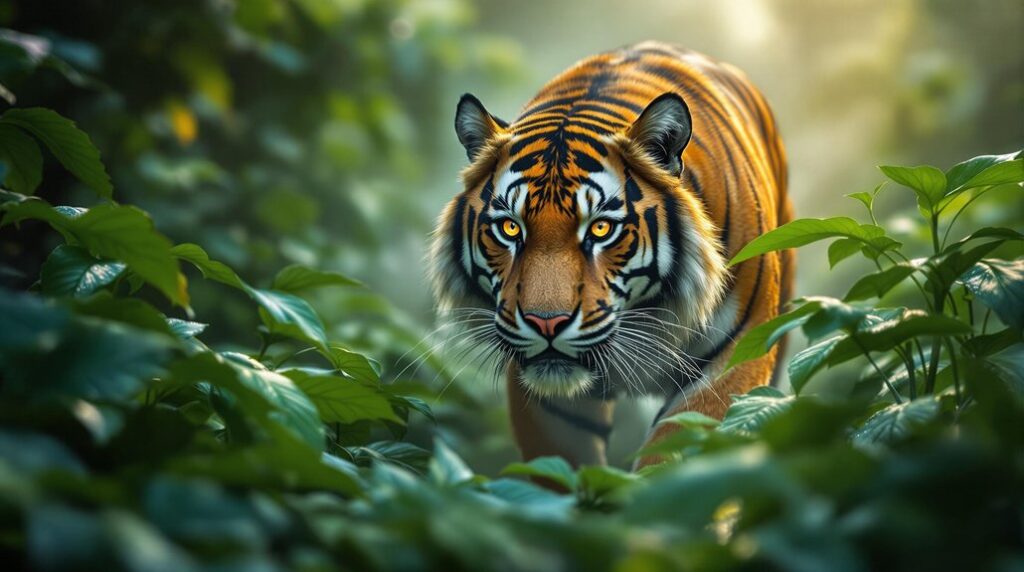This blog contains affiliate links. As part of afiiliate networks and as an Amazon Associate, I earn from qualifying purchases. If you make a purchase through these links, I may earn a small commission at no additional cost to you. I only recommend products and services that I believe in and have personally used or researched. Your support helps me continue to provide quality content—thank you!
You’re about to discover the ultimate wildlife photography gear for 2025. Whether you’re tracking elusive big cats or capturing birds in flight, your equipment choice makes all the difference between a missed opportunity and a portfolio masterpiece. From budget-friendly options like the KODAK PIXPRO to professional-grade setups with night vision capabilities, we’ve tested and selected cameras that’ll transform your wildlife photography journey. Ready to see which models made our expert list?
KODAK PIXPRO AZ425-BK 20MP Digital Camera with 42X Optical Zoom
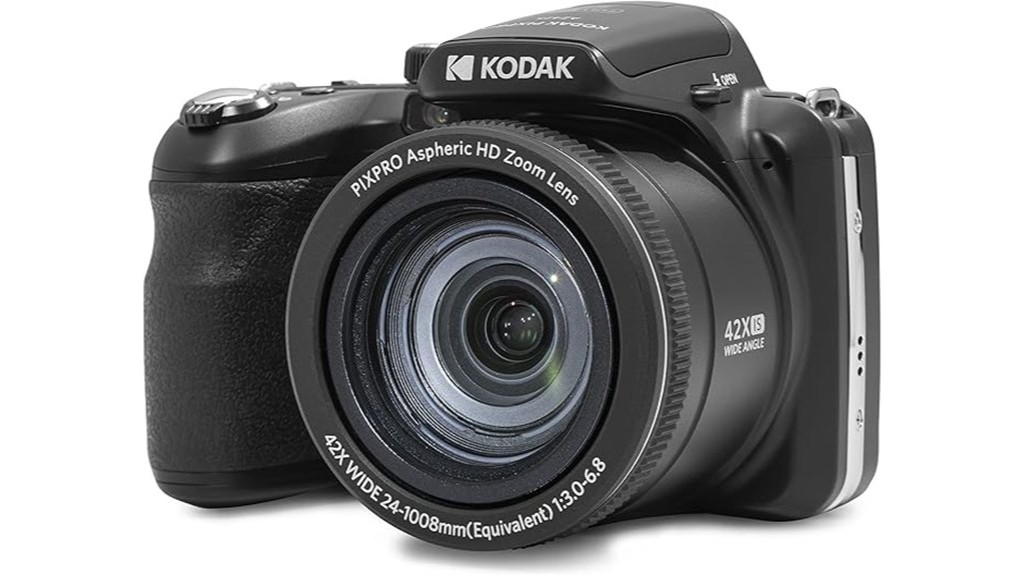
The KODAK PIXPRO AZ425-BK stands out as an entry-level wildlife photographer’s ally with its impressive 42X optical zoom capability. This 20MP camera captures distant subjects with surprising clarity while maintaining affordability.
You’ll appreciate the 24mm wide angle lens for landscape compositions and the optical image stabilization when shooting without a tripod. The one-button video access lets you quickly switch to 1080p recording when wildlife starts moving.
While it performs well in good lighting, you might face challenges in low-light conditions. Some users report blurry images at maximum zoom, so consider using a tripod for those extreme telephoto shots. The camera’s auto tracking features help keep moving animals in focus.
Best For: Budget-conscious wildlife and nature photography enthusiasts who need significant zoom capability without investing in a professional DSLR system.
Pros:
- Impressive 42X optical zoom with 20MP resolution delivers good image quality for distant subjects
- User-friendly features including one-button video access, optical image stabilization, and auto tracking
- Versatile 24mm wide angle lens and 1080p video capability provide good all-around functionality
Cons:
- Struggles with image quality in low-light conditions and may produce blurry images at maximum zoom
- Lacks some advanced features like manual focus options and the ability to save custom settings
- Some quality control concerns with reports of customers receiving open-box or returned units
Canon EOS Rebel T7 DSLR Camera with 2 Lens Kit
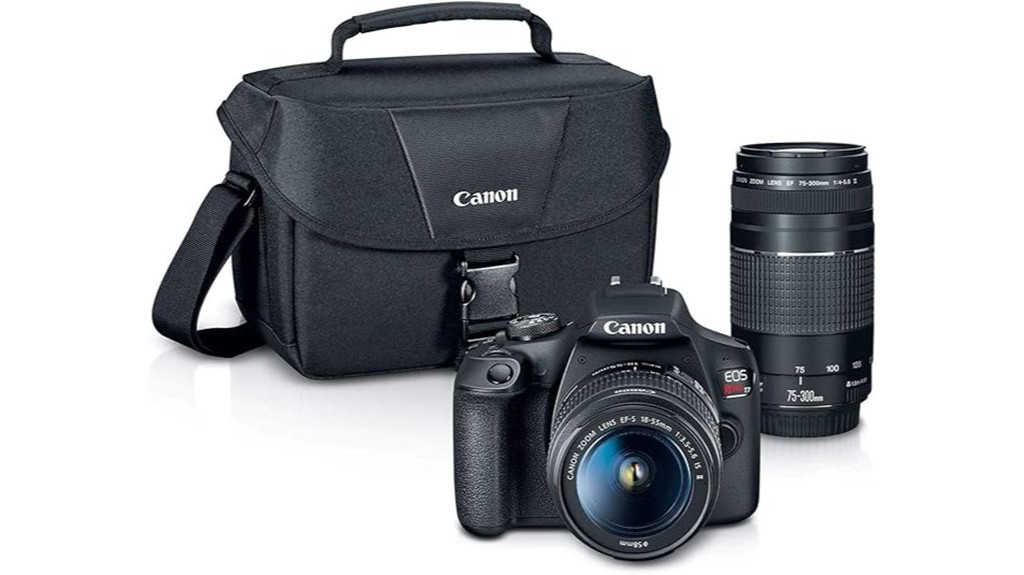
Popular among beginners venturing into wildlife photography, the Canon EOS Rebel T7 DSLR offers an impressive entry-level package with its dual lens kit. The 24.1MP sensor captures sharp images, while the included 75-300mm lens gives you access to distant subjects.
You’ll appreciate the 9-point autofocus system and ISO range up to 6400 for various lighting conditions. Though it lacks 4K video capability and image stabilization, the Full HD recording serves most wildlife documentation needs.
The camera’s Wi-Fi connectivity lets you share photos instantly from remote locations. For budget-conscious wildlife enthusiasts, this lightweight DSLR delivers quality results without breaking the bank.
Best For: Entry-level wildlife photographers seeking an affordable DSLR with decent zoom capabilities and easy-to-use features.
Pros:
- Dual lens kit includes a versatile 75-300mm telephoto lens perfect for capturing distant wildlife subjects
- 24.1MP CMOS sensor delivers sharp, detailed images even in challenging outdoor lighting conditions
- Built-in Wi-Fi and NFC technology allows for convenient photo sharing directly from remote locations
Cons:
- Lacks image stabilization in both kit lenses, potentially affecting image sharpness when shooting wildlife handheld
- Limited to Full HD video recording without 4K capabilities for wildlife documentation
- Moderate autofocus speed with only 9 focus points may struggle to track fast-moving animals
Nikon COOLPIX P950 Superzoom Digital Camera (16 MP, 83x Optical Zoom)
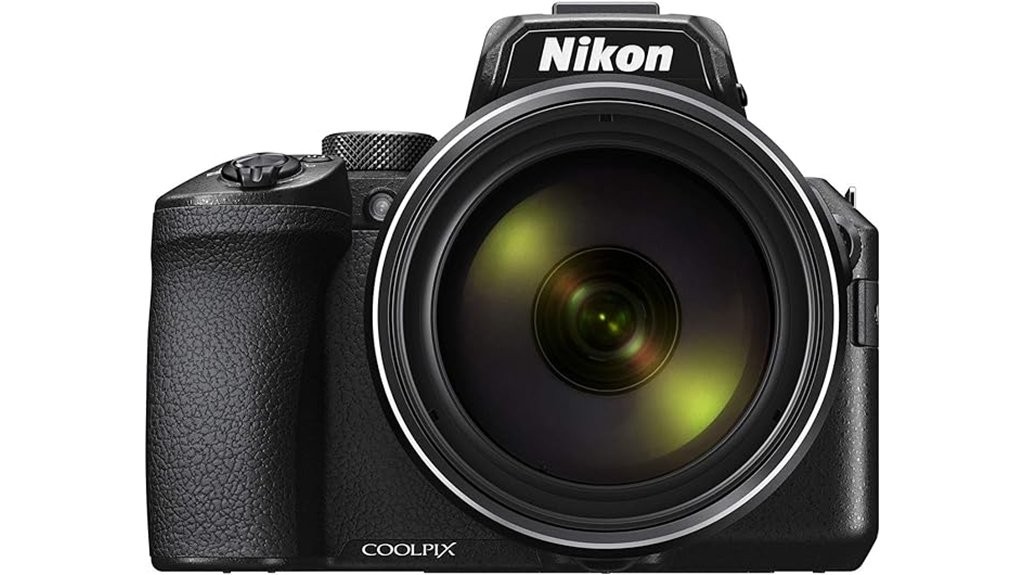
Boasting an incredible 83x optical zoom with a 2000mm maximum focal length, the Nikon COOLPIX P950 stands out as a premier choice for wildlife photographers who need to capture distant subjects with remarkable detail.
The 16MP camera features built-in Bird and Moon modes, 4K UHD video capability, and Dual Detect Optical VR stabilization that’s vital for handheld shooting at extreme zoom ranges. You’ll appreciate the vari-angle LCD screen for creative compositions and RAW format support for post-processing flexibility. While autofocus occasionally struggles with fast-moving subjects, most users find the image quality impressive, especially considering its portable form factor.
Best For: Wildlife photographers, astronomy enthusiasts, and nature lovers who need exceptional zoom capabilities to capture distant subjects without carrying multiple lenses.
Pros:
- Extraordinary 83x optical zoom with 2000mm focal length and effective image stabilization makes it perfect for wildlife and celestial photography
- Specialized Bird and Moon modes with 4K video recording enhance usability for wildlife observation
- RAW format support and vari-angle LCD screen provide creative flexibility for both casual and serious photographers
Cons:
- Autofocus system struggles with tracking fast-moving subjects, particularly in challenging lighting conditions
- Smaller sensor size (despite the 16MP resolution) limits low-light performance compared to larger sensor cameras
- Price point is relatively high for a fixed-lens camera that cannot swap lenses like DSLR or mirrorless systems
Canon EOS 4000D / Rebel T100 DSLR Camera with 18-55mm Zoom Lens
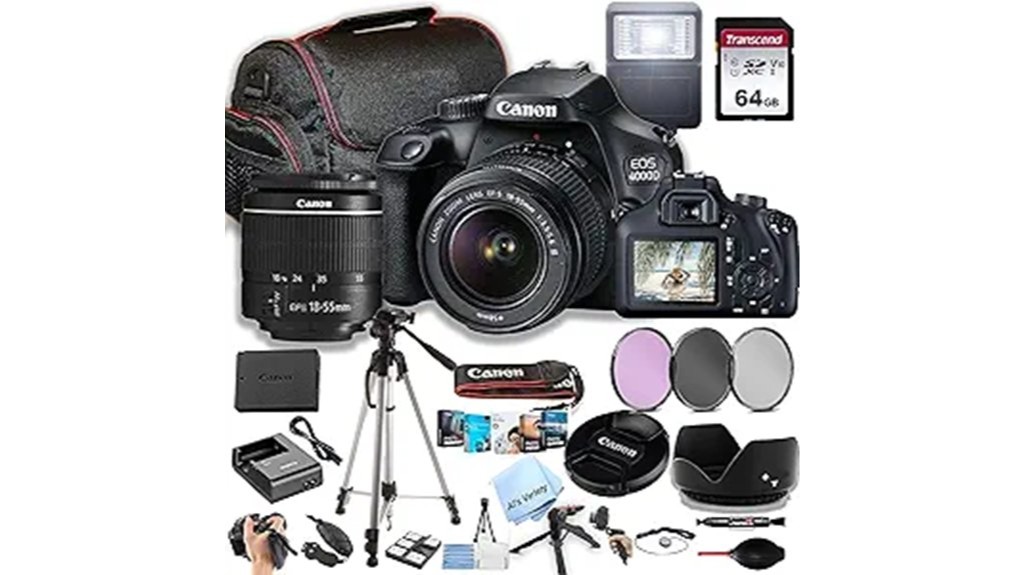
For beginner wildlife photographers on a budget, the Canon EOS 4000D (also known as the Rebel T100) offers an accessible entry point into DSLR photography without breaking the bank.
The 18MP APS-C sensor paired with the 18-55mm kit lens provides decent image quality for capturing wildlife subjects. While its 3 fps continuous shooting and 9-point autofocus system won’t track fast-moving animals as effectively as higher-end models, it’s sufficient for stationary or slow-moving subjects.
You’ll appreciate the included accessories like the 64GB memory card and tripod, though more serious wildlife work will eventually require lens upgrades with greater reach.
Best For: Budget-conscious photography beginners looking to explore wildlife photography with a basic DSLR that offers manual controls and the ability to change lenses.
Pros:
- Includes comprehensive accessories bundle with 64GB memory card, tripod, and cleaning supplies that provide good value for beginners
- Wi-Fi connectivity allows for easy photo transfer and remote shooting via Canon’s apps
- User-friendly interface with Scene Intelligent Auto mode makes it accessible for first-time DSLR users
Cons:
- Limited 3 fps continuous shooting speed and basic 9-point autofocus system struggles with fast-moving wildlife subjects
- The 18-55mm kit lens lacks the reach needed for serious wildlife photography
- Some included accessories (particularly the slave flash and filters) are of questionable quality according to customer feedback
Panasonic LUMIX FZ80D Compact Camera with 20-1200mm Zoom Lens
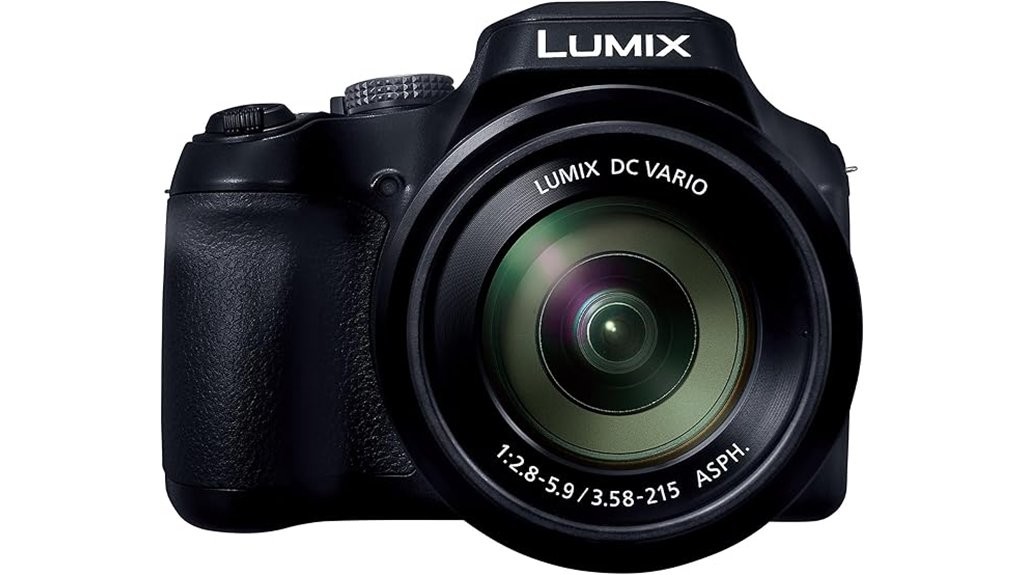
Wildlife photographers seeking an accessible entry point into telephoto photography will find the Panasonic LUMIX FZ80D compact camera an excellent all-in-one solution. Its impressive 20-1200mm zoom range lets you capture distant subjects without changing lenses.
The 4K video capability and Post Focus feature give you flexibility in the field – extract 8MP stills from video footage or adjust focus points after shooting. While low-light performance isn’t its strength, the effective POWER O.I.S. stabilization helps maintain sharpness even at maximum zoom.
For close encounters, the 1cm minimum focusing distance enables striking macro shots. You’ll appreciate the intuitive touchscreen interface and lightweight design during long treks.
Best For: Wildlife and travel photographers who want versatile telephoto and macro shooting capabilities without carrying multiple lenses or investing in expensive professional gear.
Pros:
- Impressive 20-1200mm zoom range captures everything from wide landscapes to distant wildlife in a single, compact camera
- 4K photo and video capabilities with Post Focus feature for extracting high-quality stills and adjusting focus after shooting
- Effective image stabilization helps maintain sharpness at maximum zoom, with macro shooting down to 1cm for detailed close-ups
Cons:
- Performance declines in low-light conditions, requiring manual settings adjustment and potentially a tripod
- Limited sensor size compared to DSLRs or mirrorless cameras affects overall image quality and dynamic range
- Touchscreen interface may be challenging to use in bright sunlight despite the glare-resistant viewfinder
Canon EOS 2000D/Rebel T7 DSLR Camera with Dual Lens Bundle (Renewed)
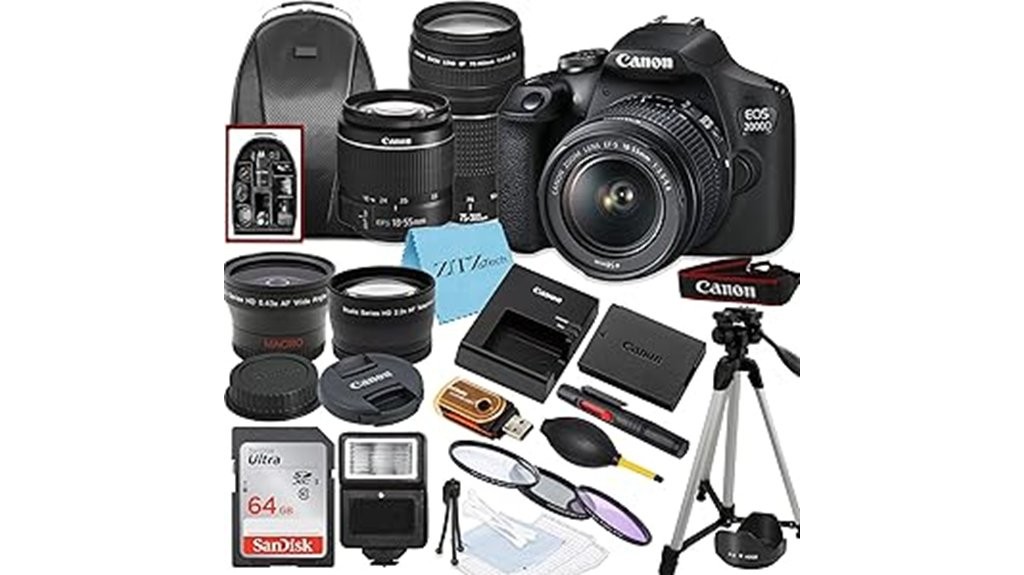
The entry-level Canon EOS 2000D/Rebel T7 DSLR camera bundle offers aspiring wildlife photographers an accessible gateway into capturing nature’s magnificence. With its 24.1MP APS-C sensor and 9-point autofocus system, you’ll capture detailed images of distant subjects.
The included 18-55mm lens works for environmental shots, while the 75-300mm telephoto lens brings distant wildlife closer. Though the bundled accessories (tripod, filters, backpack) aren’t professional-grade, they’ll get you started.
Wi-Fi connectivity lets you transfer images easily after a day in the field. For budget-conscious photographers, this renewed bundle delivers solid performance where it matters most—in the camera itself.
Best For: Budget-conscious beginner wildlife photographers looking for an entry-level DSLR with telephoto capabilities without breaking the bank.
Pros:
- 24.1MP APS-C sensor delivers detailed wildlife images with good resolution for cropping
- Versatile dual lens bundle includes a 75-300mm telephoto lens perfect for distant wildlife subjects
- Built-in Wi-Fi with NFC enables easy photo transfers after field shoots
Cons:
- Relatively slow 3 fps continuous shooting rate limits action wildlife photography
- Bundled accessories (especially tripod and backpack) are of lower quality and may need upgrading
- 9-point autofocus system is basic and may struggle with fast-moving wildlife subjects
KODAK PIXPRO AZ405-BK 20MP Digital Camera with 40X Optical Zoom
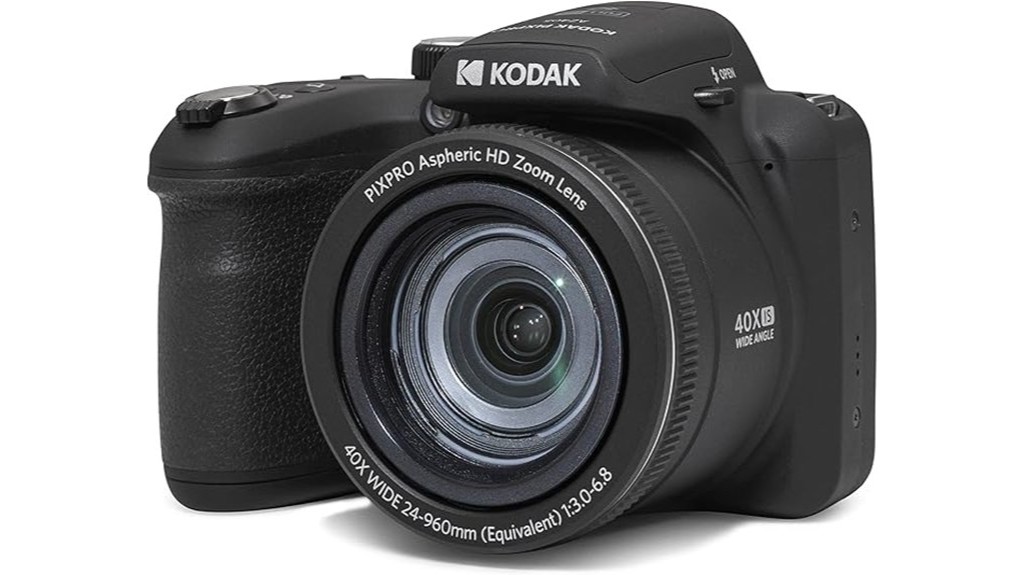
Wildlife enthusiasts seeking a budget-friendly camera with impressive zoom capabilities will find the KODAK PIXPRO AZ405-BK an excellent option. Its 40X optical zoom and 20MP CMOS sensor capture distant wildlife with remarkable clarity.
You’ll appreciate the optical image stabilization when tracking moving animals, while the 1080p HD video recording preserves memorable encounters. The 3″ LCD screen provides clear viewing even in outdoor settings.
While it lacks wireless transfer capabilities and requires patience for focusing, the image quality rivals more expensive models. Remember to pack extra AA batteries and a Class 10 SD card (sold separately) for your excursions.
For beginners and intermediate photographers, this camera delivers impressive performance without breaking the bank.
Best For: Wildlife enthusiasts, beginners, and intermediate photographers seeking a budget-friendly camera with powerful zoom capabilities for distant nature photography without investing in professional equipment.
Pros:
- Impressive 40X optical zoom with 20MP CMOS sensor delivers remarkable image clarity for distant subjects
- Optical image stabilization and 1080p HD video recording enhance wildlife photography capabilities
- User-friendly interface and settings make it accessible for photographers of varying skill levels
Cons:
- Lacks wireless photo transfer capabilities, requiring physical connection for image downloads
- Battery life is limited, especially when using advanced features, necessitating extra AA batteries
- Requires separate purchase of SD card and may need modifications (like securing loose lens cap)
Canon EOS Rebel T7 DSLR Camera Bundle with 18-55mm Lens
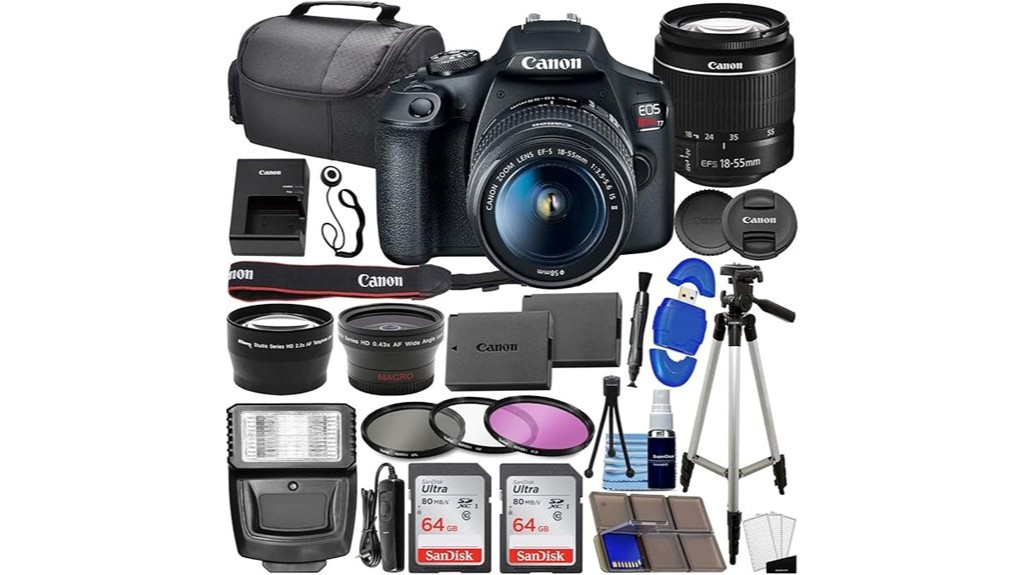
Aspiring wildlife photographers seeking an entry-level DSLR will find the Canon EOS Rebel T7 bundle offers impressive capability at an accessible price point. With its 24.1MP APS-C sensor and DIGIC 4+ processor, you’ll capture crisp wildlife images even in challenging conditions.
The bundle includes both wide-angle and telephoto auxiliary lenses, expanding your range beyond the versatile 18-55mm kit lens. This gives you flexibility when shooting subjects at varying distances without changing position.
While not as fast as professional models with its 3 fps continuous shooting, the T7’s 9-point autofocus system and expandable ISO range make it a solid foundation for developing your wildlife photography skills.
Best For: Beginner wildlife photographers looking for an affordable DSLR bundle that includes telephoto capabilities and essential accessories to start their photography journey.
Pros:
- Comprehensive bundle with wide-angle and telephoto auxiliary lenses, providing versatility for different wildlife shooting scenarios
- 24.1MP sensor delivers higher resolution images than the previous T6 model, capturing more detail in nature and wildlife shots
- Built-in Wi-Fi and NFC connectivity allows for easy sharing of photos and remote shooting capabilities
Cons:
- Limited continuous shooting speed of only 3 fps may struggle with fast-moving wildlife subjects
- 9-point AF system is basic compared to more advanced models, potentially missing focus on quick-moving animals
- Can be complex for absolute beginners to master all features and settings without additional training resources
KODAK PIXPRO FZ55-BK 16MP Digital Camera with 5X Optical Zoom
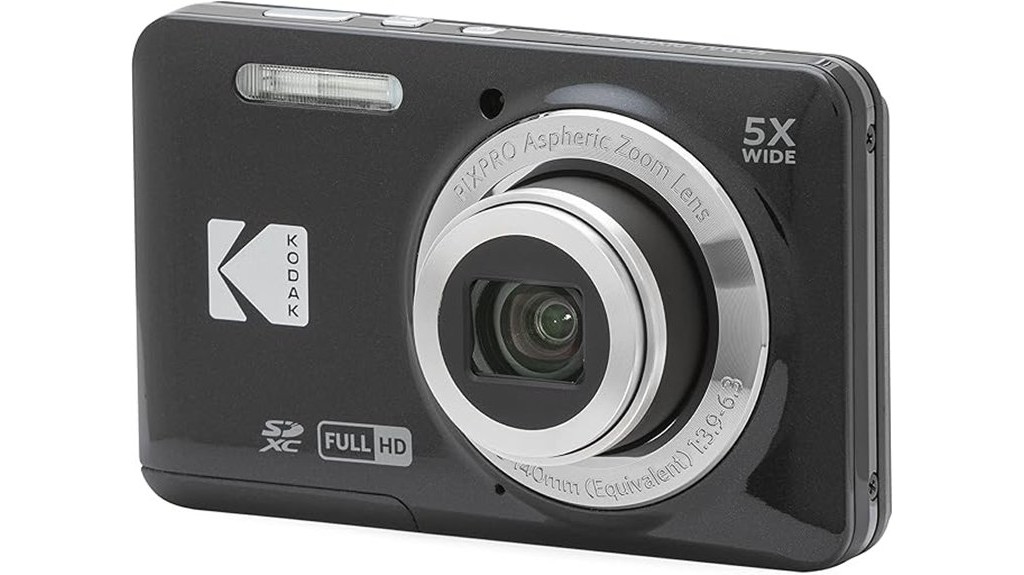
The KODAK PIXPRO FZ55-BK offers budget-conscious photographers an entry point into wildlife photography without breaking the bank. Its 16MP CMOS sensor and 5X optical zoom provide adequate reach for capturing distant subjects, though serious wildlife enthusiasts may find these specifications limiting.
While not designed specifically for wildlife, the compact design makes it suitable for nature hikes where mobility matters. The 1080P HD video capability lets you document animal behavior, but expect some quality loss when zooming.
For beginners making the shift from smartphone photography to more dedicated wildlife shooting, this camera serves as a practical starting point before investing in more specialized equipment.
Best For: Beginner photographers and casual users wanting an affordable entry-level camera for basic wildlife photography and travel documentation without the complexity of professional equipment.
Pros:
- Compact, portable design ideal for hiking and outdoor travel when mobility is important
- 5X optical zoom and 16MP sensor provide better wildlife shooting capabilities than smartphones
- User-friendly interface with multiple shooting modes makes it accessible for photography novices
Cons:
- Limited zoom range (5X) restricts capturing distant wildlife subjects compared to specialized wildlife cameras
- Video quality degrades noticeably when using the zoom feature
- Basic specifications and features that serious wildlife photographers will quickly outgrow
8K Digital Camera for Photography and Vlogging with WiFi and Touchscreen
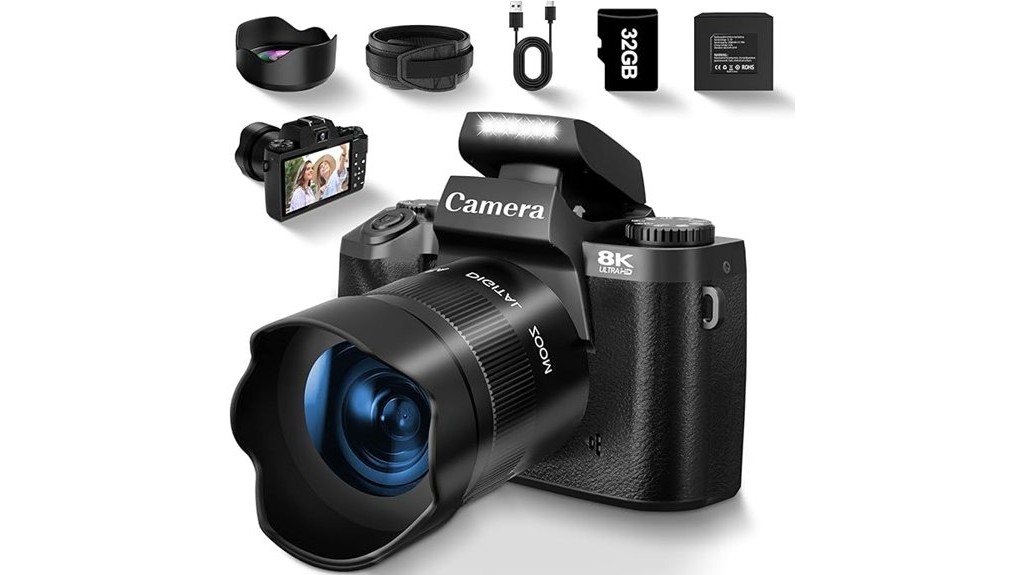
Modern content creators seeking both versatility and quality will find the 8K Digital Camera an exceptional tool for wildlife photography and vlogging. The 64MP resolution and 4K video capabilities capture stunning details of wildlife in their natural habitats.
You’ll appreciate the large 4.0-inch touchscreen when adjusting settings quickly in the field. The 3000mAh battery guarantees you won’t miss vital moments during extended outdoor shoots. Transfer your captures instantly using WiFi connectivity, perfect for remote locations.
While some users compare the photo quality unfavorably to smartphones, the included accessories (32GB card, lens hood, camera bag) provide everything you need for immediate wildlife adventures.
Best For: Beginner content creators and wildlife photography enthusiasts who need a versatile camera with good battery life and convenient sharing options.
Pros:
- Large 4.0-inch touchscreen makes navigation and setting adjustments intuitive
- Long-lasting 3000mAh battery ideal for extended outdoor shooting sessions
- Complete accessory package including 32GB card, lens hood, and camera bag provides immediate shooting capability
Cons:
- Photo quality may not match current smartphone capabilities as noted by some users
- Marketed as 8K camera but actually offers 4K video resolution and 64MP photos
- Some users report the camera feels like a toy rather than professional equipment
Canon Powershot SX70 20.3MP Digital Camera with 65x Optical Zoom
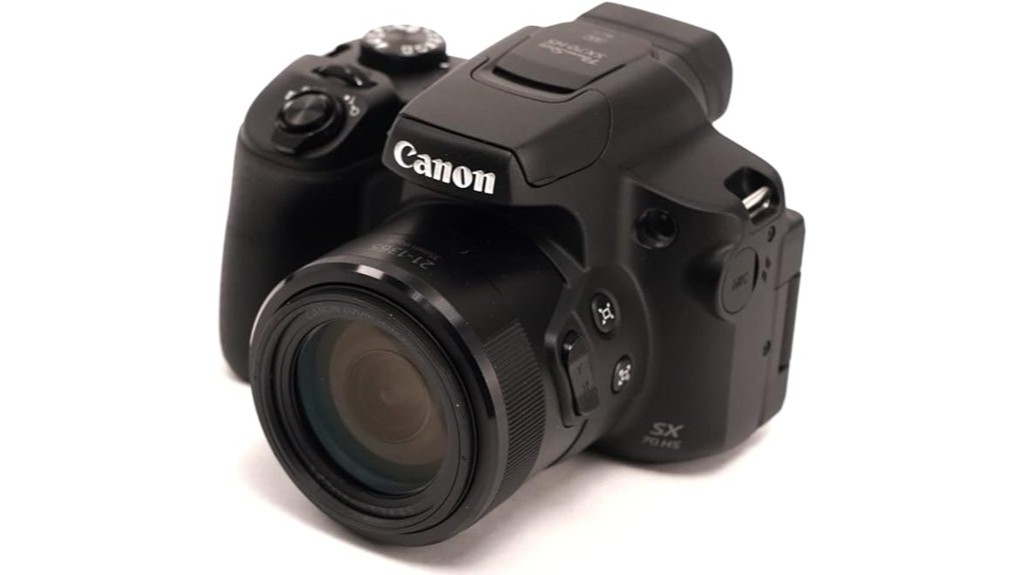
Wildlife photographers seeking a versatile, beginner-friendly camera will find the Canon Powershot SX70 an excellent entry point into the field. Its impressive 65x optical zoom lets you capture distant subjects without disturbing their natural behavior.
The 20.3MP sensor delivers quality images sufficient for decent prints, while the effective image stabilization helps manage that powerful zoom. You’ll appreciate the lightweight design during long field sessions, though you’ll want a tripod for maximum zoom clarity.
While its low-light performance can’t match DSLRs, and the plastic construction isn’t all-weather ready, the intuitive controls and 4K video capabilities make it ideal for wildlife enthusiasts not ready to invest in professional equipment.
Best For: Amateur wildlife photographers and nature enthusiasts seeking an affordable, lightweight camera with impressive zoom capabilities for capturing distant subjects without investing in professional equipment.
Pros:
- Powerful 65x optical zoom ideal for wildlife and bird photography without disturbing subjects
- Lightweight, portable design makes it comfortable for extended field use and travel
- User-friendly interface with effective auto settings that allow beginners to quickly start shooting quality images
Cons:
- Struggles in low-light conditions compared to DSLRs or mirrorless cameras
- Plastic construction lacks weather-sealing and feels less durable than previous models
- Battery life is limited, requiring frequent charging during extended shooting sessions
Trail Camera WiFi 4K 64MP with Night Vision and Waterproof Design
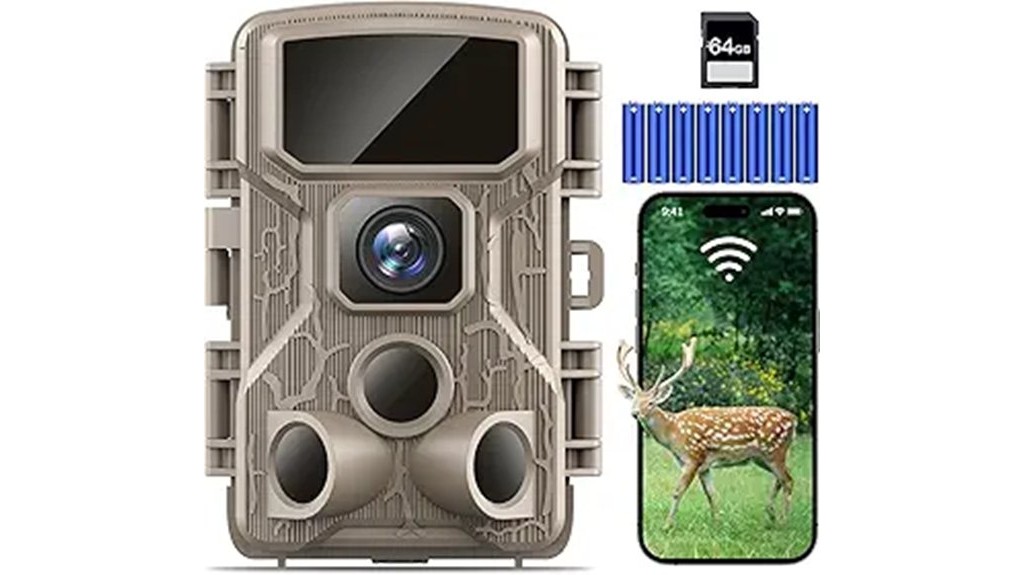
Serious wildlife photographers and property monitors will appreciate the Punvoe Trail Camera’s professional-grade capabilities, which include 64MP still images and UHD 4K video recording.
With a lightning-fast 0.1-second trigger speed and 130-degree wide-angle view, you won’t miss vital moments. The camera’s 45 no-glow LEDs provide night vision up to 100 feet, while its IP67 weatherproof rating guarantees reliability in harsh conditions.
You can control everything through the TrailCam GO app, previewing and downloading media directly to your smartphone via WiFi connection. The 3.5-week battery life even in cold weather makes this trail camera ideal for extended monitoring sessions.
Best For: Wildlife enthusiasts, property owners, and outdoor security professionals seeking a high-resolution, weather-resistant camera with remote monitoring capabilities.
Pros:
- Impressive 64MP images and 4K video with ultra-fast 0.1-second trigger speed capture every detail of wildlife or security events
- Robust IP67 weatherproof design and exceptional 3.5-week battery life make it reliable for extended deployment in harsh conditions
- Convenient smartphone control via the TrailCam GO app allows remote preview and downloads without disturbing the camera’s position
Cons:
- WiFi functionality is limited to direct connection with smartphones and not compatible with home WiFi networks
- Bluetooth range is restricted to 20 feet, which may require close proximity for initial setup
- Higher price point compared to basic trail cameras, though justified by premium features and image quality
Factors to Consider When Choosing Cameras for Wildlife Photography
When you’re choosing a camera for wildlife photography, you’ll need to evaluate several critical features that can make or break your shots in the field. You should prioritize models with extensive optical zoom range, effective image stabilization, and lightning-fast autofocus performance to capture animals in motion. Don’t overlook the importance of superior low-light capabilities and extended battery life, as wildlife opportunities often occur at dawn, dusk, or in remote locations where charging isn’t an option.
Optical Zoom Range
Since animals rarely pose at convenient distances, a camera’s optical zoom range plays an essential role in wildlife photography success. You’ll want to prioritize cameras offering at least 40X optical zoom, which allows you to capture detailed images of distant subjects without sacrificing quality.
When shooting with high magnification, optical image stabilization becomes critical. It helps maintain sharpness by counteracting the hand tremors that become magnified at extended focal lengths. Look for cameras that combine powerful zoom with wide-angle capabilities (around 24mm), giving you versatility to capture both distant wildlife and broader environmental contexts.
Remember that sensor quality complements zoom functionality. Higher megapixel counts provide additional cropping flexibility, effectively extending your reach when photographing shy or distant animals in their natural habitats.
Image Stabilization Capabilities
Powerful zoom capabilities alone won’t guarantee sharp wildlife photos without robust image stabilization technology. When you’re tracking a distant bird or following a running cheetah, camera shake becomes your enemy, particularly with telephoto lenses that amplify even the slightest tremors.
Look for cameras featuring optical image stabilization (OIS) or vibration reduction (VR) systems that compensate for hand movements, allowing you to shoot at slower shutter speeds while maintaining clarity. Dual detect optical VR systems excel when tracking unpredictable wildlife movement, giving you an edge in dynamic situations.
The combination of effective stabilization with higher megapixel counts provides additional flexibility for cropping without sacrificing detail. Built-in stabilization technology is particularly valuable when shooting handheld at maximum zoom or capturing fast action in challenging lighting conditions.
Autofocus Speed Performance
Nothing separates a stunning wildlife shot from a missed opportunity faster than autofocus performance. When tracking unpredictable subjects, you’ll need a camera that can focus in fractions of a second—ideally between 0.1 and 0.3 seconds—to capture decisive moments.
Look for models with abundant autofocus points, as these greatly improve your ability to track moving wildlife across the frame. Cameras with specialized tracking modes like “AI Servo” or “Continuous AF” will keep your subjects sharp even during erratic movement.
Don’t overlook low-light performance when evaluating autofocus capabilities. Superior models maintain fast, accurate focus even at dawn or dusk—prime times for wildlife activity. Your perfect wildlife camera should deliver reliable autofocus regardless of challenging lighting conditions or unexpected animal movements.
Low-Light Shooting Ability
Low-light conditions at dawn and dusk often present wildlife photographers with their greatest challenges—and opportunities. When selecting a camera for these critical moments, prioritize models with larger sensors—full-frame or APS-C formats will capture more light and produce cleaner images with less noise.
Look for cameras with high ISO capabilities (12800+) that maintain image quality even when sensitivity is increased. Pair your camera with fast lenses featuring wide apertures (f/2.8 or wider) to maximize light capture and enable faster shutter speeds that freeze animal movement.
Don’t overlook optical image stabilization, which compensates for hand movement during longer exposures. Finally, make certain your camera’s autofocus system performs reliably in dim conditions—wildlife won’t wait while your camera hunts for focus in the fading light.
Battery Life Longevity
Battery life determines how long you’ll stay in the field capturing wildlife behaviors without interruption. When selecting your wildlife camera, prioritize models with efficient lithium-ion batteries that can last days or even weeks on a single charge.
Your shooting habits directly impact battery performance. Rapid-fire sequences and high-resolution video will drain power much faster than intermittent still photography. Look for cameras offering power-saving modes or compatible solar panel options for extended field sessions.
Premium trail cameras can operate for weeks on standard AA batteries, even in cold conditions. However, remember that enhanced features like higher resolution settings and wireless connectivity will consume more power. When making your selection, carefully balance your need for extended battery life against the camera’s critical performance features for your specific wildlife photography goals.
Weather Resistance Rating
When venturing into the unpredictable wilderness, your camera’s weather resistance rating becomes as crucial as its optical capabilities. Look for IP ratings like IP66, which indicates a dust-tight body that can withstand powerful water jets—essential when you’re caught in unexpected downpours.
The best wildlife cameras feature materials that resist rust and corrosion, ensuring durability during extended field expeditions. Check for models that operate across extreme temperature ranges (-20°C to 60°C) so you’ll capture that perfect shot whether in arctic conditions or tropical heat.
Don’t overlook the importance of weather-sealed bodies paired with resistant lenses—this combination creates a thorough defense system against environmental threats. Premium models offer additional protection with water-resistant battery compartments and sealed circuit boards, greatly extending your camera’s lifespan in challenging outdoor conditions.
Sensor Size Importance
Just as weather protection shields your equipment from the elements, a camera’s sensor acts as the heart of your image quality in wildlife photography. Larger sensors like full-frame models excel in low light, capturing more detail with less noise during dawn and dusk shoots when animals are most active.
While full-frame sensors offer superior depth of field control and dynamic range, don’t overlook the advantages of APS-C sensors. Their crop factor effectively extends your lens’s reach—a significant benefit when photographing distant subjects. This feature often makes APS-C cameras a practical choice for wildlife photographers on a budget.
Consider resolution carefully, as higher megapixel counts allow for more aggressive cropping—often essential when you can’t physically get closer to skittish wildlife. Modern back-illuminated sensors further enhance low-light performance, critical for forest or twilight photography.
Lens Compatibility Options
Every wildlife photographer’s success hinges on lens compatibility when selecting a camera system. You’ll want to prioritize bodies that support interchangeable lenses, giving you the flexibility to switch between wide-angle and telephoto options based on your shooting scenario.
For wildlife work, compatibility with telephoto lenses in the 200-600mm range is essential, allowing you to capture distant subjects without disturbing natural behaviors. Look for camera mounts that offer extensive third-party lens support, expanding your specialized wildlife photography toolkit.
Pay attention to the maximum aperture capabilities of compatible lenses—wider openings (f/2.8-f/4) dramatically improve low-light performance during dawn and dusk when animals are most active. Finally, understand your camera’s crop factor, as this affects effective focal length and can maximize your reach when photographing elusive wildlife.
Conclusion
You’ve now discovered the top wildlife photography cameras for 2025, from the powerful zoom of Nikon’s COOLPIX P950 to the beginner-friendly Canon Rebel T7. Whether you’re tracking elusive wildlife or capturing stunning nature close-ups, your perfect camera awaits. Remember to prioritize optical zoom, image quality, and durability when making your choice. With these professional picks, you’ll be capturing breathtaking wildlife moments in no time.

Erzsebet Frey (Eli Frey) is an ecologist and online entrepreneur with a Master of Science in Ecology from the University of Belgrade. Originally from Serbia, she has lived in Sri Lanka since 2017. Eli has worked internationally in countries like Oman, Brazil, Germany, and Sri Lanka. In 2018, she expanded into SEO and blogging, completing courses from UC Davis and Edinburgh. Eli has founded multiple websites focused on biology, ecology, environmental science, sustainable and simple living, and outdoor activities. She enjoys creating nature and simple living videos on YouTube and participates in speleology, diving, and hiking.
🌿 Explore the Wild Side!
Discover eBooks, guides, templates and stylish wildlife-themed T-shirts, notebooks, scrunchies, bandanas, and tote bags. Perfect for nature lovers and wildlife enthusiasts!
Visit My Shop →
